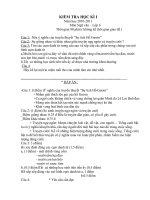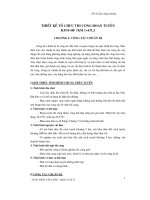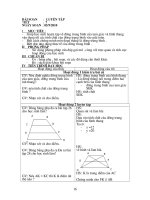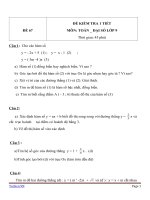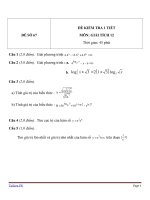- Trang chủ >>
- Mầm non - Tiểu học >>
- Lớp 1
1 67 parent booklet
Bạn đang xem bản rút gọn của tài liệu. Xem và tải ngay bản đầy đủ của tài liệu tại đây (1.87 MB, 18 trang )
1.67
a
d
e
n
i
d Seek
H
n and Stephen Thom
Thompso
pson
Jane
Parent Booklet 1
© 2016 Cengage Learning
Contents
Introduction to Hide and Seek . . . . . . . . . . . . . . . . 3
Course rationale . . . . . . . . . . . . . . . . . . . . . . . . . . 3
Course structure . . . . . . . . . . . . . . . . . . . . . . . . . . 4
Hide and Seek setting and characters . . . . . . . . . . 5
Rhymes: chants and songs . . . . . . . . . . . . . . . . . . 5
Hide and Seek early reading programme . . . . . . . 6
Hide and Seek early writing programme . . . . . . . . 7
Parental involvement . . . . . . . . . . . . . . . . . . . . . . 8
Ways to help your child . . . . . . . . . . . . . . . . . . . . 8
Parent-child activities for Pupil’s Book 1
and Activity Book 1 . . . . . . . . . . . . . . . . . . . . . . . 9
2
© 2016 Cengage Learning
Introduction
Your child is learning English with Hide and Seek, a
new three-level British English course for children in
Kindergarten classes which takes them from age three
to age six and the start of their Primary education.
The methodology of Hide and Seek involves parents
(or carers) in their child’s education. Support from
parents is very important and we have provided some
notes on page 8 as to how you can support your child.
Objectives of Hide and Seek
• Provide a fun and structured learning experience.
• Encourage a positive attitude to learning English.
• Provide interesting, age-appropriate materials and
activities for children to meet and practise a range of
English vocabulary and structures.
• Provide a course based on the internationallyrecognised Statutory Early Years Foundation Stage
Framework (England) and the National Curriculum
in England: Primary Curriculum Key Stage 1
Standards (where applicable to Reception) in
English, Maths and Science.
• Introduce the English alphabet (in Level 1) and
phonic sounds for the letters and letter combinations
(in Levels 2 and 3).
• Introduce the children to basic Numeracy and simple
maths, such as counting on, counting in tens.
• Introduce the children to simple Science topics to
develop their understanding of the world around
them.
• Introduce the idea of good behaviour in school and
citizenship through simple Values topics, set in school
and at home.
• Introduce Art and craft activities to help the children
develop their creativity and motor skills through fun
and interesting activities.
Course rationale
Hide and Seek aims to help young children develop
educationally, emotionally and linguistically in
preparation for Primary education. Each child is different
and each child will have different abilities. Some children
will be ready to start learning a new language, some will
not. Some children will be better at English, Maths or
Science than others. It is important that each child learns
at his or her own pace, and is encouraged to try and is
praised by teachers and parents for trying. It is important
that children are not over-corrected or made to feel silly
if they make a mistake.
Children are naturally motivated and enthusiastic
to learn. It is important for them to enjoy their first
educational experience and keep their enthusiasm. It is
also important to remember that children of this age will
learn quickly and forget quickly. The amount of teaching
is not expected to equal the amount of language that the
children can produce.
Hide and Seek is based on the Statutory Early Years
Foundation Stage Framework (England) (EYFS)
and the National Curriculum in England: Primary
Curriculum Key Stage 1 Standards (where applicable
to Reception). The Early Years Foundation Stage
Framework is a document which sets out standards for
learning and development for young children from birth
to five years of age and is designed for Kindergarten
and Nursery schools in the UK. The standards promote
teaching and learning to ensure ‘school readiness’.
There are seven areas of learning and development
that must be included in an educational programme
and these strands are included in the thinking and
methodology behind Hide and Seek.
• Language and communication
Children should have the opportunity to experience a rich
language environment to develop confidence and skills in
expressing themselves, and to speak and listen in a range
of situations.
• Physical development
Children should be active and interactive, and understand
the importance of physical activity and a healthy diet.
• Personal, social and emotional development
Children should be helped to develop a positive sense
of themselves, to have respect for others, to learn to
manage their own feelings, to understand appropriate
behaviour in a group and to have confidence in their own
abilities.
The EYFS also requires that an educational programme
includes:
• Literacy
Children should learn to link sounds and letters and begin
to read and write (in English).
• Maths
Children should learn to count, understand and use
numbers, do simple addition and subtraction, and
describe shapes, space and measures.
• Understanding the world (Science)
Children should be guided to make sense of the world
around them and their community. They should explore
and play with a variety of media and materials, and have
opportunities to explore, observe and find out about
people, places, technology and the environment.
• Expressive arts and design
Children should have the opportunity to explore and
play with a range of media and materials, and have
opportunities to share their thoughts and feelings
through art, music (if culturally appropriate), movement,
role-play and design.
© 2016 Cengage Learning
3
Course structure
Each level of Hide and Seek has a Pupil’s Book and
an Activity Book (with audio CD) which work closely
together.
Each Pupil’s Book has 10 Units. Each Unit has a theme
and is divided into five sections with two Lessons in
each section. Each section explores the theme in a
different way and gives the children the opportunity to
learn English and Literacy through other subject areas:
Maths, Science, Values and Art and craft. (The Values
and Art and craft sections have one lesson each.)
Literacy and English – Lessons 1 and 2 in each Unit
In Level 1, the children learn the name of a letter of the
alphabet in each Lesson. The letters are presented in
alphabetical order. The children learn to recognise each
letter and to trace it in the air, on their desks etc. using
the correct letter formation. An example of each letter
with the starting point (a red dot) is given in the letter
box in the bottom corner of each Literacy and English
page.
In Levels 2 and 3 the children start to learn phonics.
A phoneme (the sound a letter makes) is introduced
for each letter in each Literacy and English Lesson. The
phonemes are introduced in frequency groups, so that
the most common letter-sounds are learned first: s, t, p, a
for example, rather than the sounds for the letters a, b,
c, d. This means that children quickly learn to read short,
simple ‘decodable’ words (words which are pronounced
in the same way that they are spelled). The children learn
to link each letter shape with its sound. These soundfrequency groups are described in the UK National
Strategies Letters and Sounds Guidelines. The teacher
will regularly practise sounding out familiar words with
the children in the Lessons, so that the children learn to
break down short words into sound parts, for example:
c-a-t – cat, and so associate letters with their sounds.
Phonics and sounding out words are practised in every
Lesson in a Unit, to give the children regular practice and
to build their confidence.
In Level 2, the children start to learn to read short words
that appear on the Pupil’s Book pages.
In Level 3, the children start to read short sentences in
speech bubbles and short captions which appear on the
Pupil’s Book pages.
See Hide and Seek early reading programme (page 6)
for more information.
Numeracy and Maths – Lessons 3 and 4 in each Unit
Hide and Seek aims to introduce and develop
basic Numeracy in English and introduce simple
Mathematical concepts, such as two-dimensional ����������������������������������������������������������������������������������������������������������������������������������������������������������������������������������������������������������������������������������������������������������������������������������������������������������������������������������������������������������������������������������������������������������������������������������������������������������������������������������������������������������������������������������������������������������������������������������������������������������������������������������������������������������������������������������������������������������������������������������������������������������������������������������������������������������������������������������������������������������������������������������������������������������������������������������������������������������������������������������������������������������������������������������������������������������������������������������������������������������������������������������������������������������������������������������������������������������������������������������������������������������������������������������������������������������������������������������������������������������������������������������������������������������������������������������������������������������������������������������������������������������������������������������������������������������������������������������������������������������������������������������������������������������������������������������������������������������������������������������������������������������������������������������������������������������������������������������������������������������������������������������������������������������������������������������������������������������������������������������������������������������������������������������������������������������������������������������������������������������������������������������������������������������������������������������������������������������������������������������������������������������������������������������������������������������������������������������������������������������������������������������������������������������������������������������������������������������������������������������������������������������������������������������������������������������������������������������������������������������������������������������������������������������������������������������������������������������������������������������������������������������������������������������������������������������������������������������������������������������������������������������������������������������������������������������������������������������������������������������������������������������������������������������������������������������������������������������������������������������������������������������������������������������������������������������������������������������������������������������������������������������������������������������������������������������������������������������������������������������������������������������������������������������������������������������������������������������������������������������������������������������������������������������������������������������������������������������������������������������������������������������������������������������������������������������������������������������������������������������������������������������������������������������������������������������������������������������������������������������������������������������������������������������������������������������������������������������������������������������������������������������������������������������������������������������������������������������������������������������������������������������������������������������������������������������������������������������������������������������������������������������������������������������������������������������������������������������������������������������������������������������������������������������������������������������������������������������������������������������������������������������������������������������������������������������������������������������������������������������������������������������������������������������������������������������������������������������������������������������������������������������������������������������������������������������������������������������������������������������������������������������������������������������������������������������������������������������������������������������������������������������������������������������������������������������������������������������������������������������������������������������������������������������������������������������������������������������������������������������������������������������������������������������������������������������������������������������������������������������������������������������������������������������������������������������������������������������������������������������������������������������������������������������������������������������������������������������������������������������������������������������������������������������������������������������������������������������������������������������������������������������������������������������������������������������������������������������������������������������������������������������������������������������������������������������������������������������������������������������������������������������������������������������������������������������������������������������������������������������������������������������������������������������������������������������������������������������������������������������������������������������������������������������������������������������������������������������������������������������������������������������������������������������������������������������������������������������������������������������������������������������������������������������������������������������������������������������������������������������������������������������������������������������������������������������������������������������������������������������������������������������������������������������������������������������������������������������������������������������������������������������������������������������������������������������������������������������������������������������������������������������������������������������������������������������������������������������������������������������������������������������������������������������������������������������������������������������������������������������������������������������������������������������������������������������������������������������������������������������������������������������������������������������������������������������������������������������������������������������������������������������������������������������������������������������������������������������������������������������������������������������������������������������������������������������������������������������������������������������������������������������������������������������������������������������������������������������������������������������������������������������������������������������������������������������������������������������������������������������������������������������������������������������������������������������������������������������������������������������������������������������������������������������������������������������������������������������������������������������������������������������������������������������������������������������������������������������������������������������������������������������������������������������������������������������������������������������������������������������������������������������������������������������������������������������������������������������������������������������������������������������������������������������������������������������������������������������������������������������������������������������������������������������������������������������������������������������������������������������������������������������������������������������������������������������������������������������������������������������������������������������������������������������������������������������������������������������������������������������������������������������������������������������������������������������������������������������������������������������������������������������������������������������������������������������������������������������������������������������������������������������������������������������������������������������������������������������������������������������������������������������������������������������������������������������������������������������������������������������������������������������������������������������������������������������������������������������������������������������������������������������������������������������������������������������������������������������������������������������������������������������������������������������������������������������������������������������������������������������������������������������������������������������������������������������������������������������������������������������������������������������������������������������������������������������������������������������������������������������������������������������������������������������������������������������������������������������������������������������������������������������������������������������������������������������������������������������������������������������������������������������������������������������������������������������������������������������������������������������������������������������������������������������������������������������������������������������������������������������������������������������������������������������������������������������������������������������������������������������������������������������������������������������������������������������������������������������������������������������������������������������������������������������������������������������������������������������������������������������������������������������������������������������������������������������������������������������������������������������������������������������������������������������������������������������������������������������������������������������������������������������������������������������������������������������������������������������������������������������������������������������������������������������������������������������������������������������������������������������������������������������������������������������������������������������������������������������������������������������������������������������������������������������������������������������������������������������������������������������������������������������������������������������������������������������������������������������������������������������������������������������������������������������������������������������������������������������������������������������������������������������������������������������������������������������������������������������������������������������������������������������������������������������������������������������������������������������������������������������������������������������������������������������������������������������������������������������������������������������������������������������������������������������������������������������������������������������������������������������������������������������������������������������������������������������������������������������������������������������������������������������������������������������������������������������������������������������������������������������������������������������������������������������������������������������������������������������������������������������������������������������������������������������������������������������������������������������������������������������������������������������������������������������������������������������������������������������������������������������������������������������������������������������������������������������������������������������������������������������������������������������������������������������������������������������������������������������������������������������������������������������������������������������������������������������������������������������������������������������������������������������������������������������������������������������������������������������������������������������������������������������������������������������������������������������������������������������������������������������������������������������������������������������������������������������������������������������������������������������������������������������������������������������������������������������������������������������������������������������������������������������������������������������������������������������������������������������������������������������������������������������������������������������������������������������������������������������������������������������������������������������������������������������������������������������������������������������������������������������������������������������������������������������������������������������������������������������������������������������������������������������������������������������������������������������������������������������������������������������������������������������������������������������������������������������������������������������������������������������������������������������������������������������������������������������������������������������������������������������������������������������������������������������������������������������������������������������������������������������������������������������������������������������������������������������������������������������������������������������������������������������������������������������������������������������������������������������������������������������������������������������������������������������������������������������������������������������������������������������������������������������������������������������������������������������������������������������������������������������������������������������������������������������������������������������������������������������������������������������������������������������������������������������������������������������������������������������������������������������������������������������������������������������������������������������������������������������������������������������������������������������������������������������������������������������������������������������������������������������������������������������������������������������������������������������������������������������������������������������������������������������������������������������������������������������������������������������������������������������������������������������������������������������������������������������������������������������������������������������������������������������������������������������������������������������������������������������������������������������������������������������������������������������������������������������������������������������������������������������������������������������������������������������������������������������������������������������������������������������������������������������������������������������������������������������������������������������������������������������������������������������������������������������������������������������������������������������������������������������������������������������������������������������������������������������������������������������������������������������������������������������������������������������������������������������������������������������������������������������������������������������������������������������������������������������������������������������������������������������������������������������������������������������������������������������������������������������������������������������������������������������������������������������������������������������������������������������������������������������������������������������������������������������������������������������������������������������������������������������������������������������������������������������������������������������������������������������������������������������������������������������������������������������������������������������������������������������������������������������������������������������������������������������������������������������������������������������������������������������������������������������������������������������������������������������������������������������������������������������������������������������������������������������������������������������������������������������������������������������������������������������������������������������������������������������������������������������������������������������������������������������������������������������������������������������������������������������������������������������������������������������������������������������������������������������������������������������������������������������������������������������������������������������������������������������������������������������������������������������������������������������������������������������������������������������������������������������������������������������������������������������������������������������������������������������������������������������������������������������������������������������������������������������������������������������������������������������������������������������������������������������������������������������������������������������������������������������������������������������������������������������������������������������������������������������������������������������������������������������������������������������������������������������������������������������������������������������������������������������������������������������������������������������������������������������������������������������������������������������������������������������������������������������������������������������������������������������������������������������������������������������������������������������������������������������������������������������������������������������������������������������������������������������������������������������������������������������������������������������������������������������������������������������������������������������������������������������������������������������������������������������������������������������������������������������������������������������������������������������������������������������������������������������������������������������������������������������������������������������������������������������������������������������������������������������������������������������������������������������������������������������������������������������������������������������������������������������������������������������������������������������������������������������������������������������������������������������������������������������������������������������������������������������������������������������������������������������������������������������������������������������������������������������������������������������������������������������������������������������������������������������������������������������������������������������������������������������������������������������������������������������������������������������������������������������������������������������������������������������������������������������������������������������������������������������������������������������������������������������������������������������������������������������������������������������������������������������������������������������������������������������������������������������������������������������������������������������������������������������������������������������������������������������������������������������������������������������������������������������������������������������������������������������������������������������������������������������������������������������������������������������������������������������������������������������������������������������������������������������������������������������������������������������������������������������������������������������������������������������������������������������������������������������������������������������������������������������������������������������������������������������������������������������������������������������������������������������������������������������������������������������������������������������������������������������������������������������������������������������������������������������������������������������������������������������������������������������������������������������������������������������������������������������������������������������������������������������������������������������������������������������������������������������������������������������������������������������������������������������������������������������������������������������������������������������������������������������������������������������������������������������������������������������������������������������������������������������������������������������������������������������������������������������������������������������������������������������������������������������������������������������������������������������������������������������������������������������������������������������������������������������������������������������������������������������������������������������������������������������������������������������������������������������������������������������������������������������������������������������������������������������������������������������������������������������������������������������������������������������������������������������������������������������������������������������������������������������������������������������������������������������������������������������������������������������������������������������������������������������������������������������������������������������������������������������������������������������������������������������������������������������������������������������������������������������������������������������������������������������������������������������������������������������������������������������������������������������������������������������������������������������������������������������������������������������������������������������������������������������������������������������������������������������������������������������������������������������������������������������������������������������������������������������������������������������������������������������������������������������������������������������������������������������������������������������������������������������������������������������������������������������������������������������������������������������������������������������������������������������������������������������������������������������������������������������������������������������������������������������������������������������������������������������������������������������������������������������������������������������������������������������������������������������������������������������������������������������������������������������������������������������������������������������������������������������������������������������������������������������������������������������������������������������������������������������������������������������������������������������������������������������������������������������������������������������������������������������������������������������������������������������������������������������������������������������������������������������������������������������������������������������������������������������������������������������������������������������������������������������������������������������������������������������������������������������������������������������������������������������������������������������������������������������������������������������������������������������������������������������������������������������������������������������������������������������������������������������������������������������������������������������������������������������������������������������������������������������������������������������������������������������������������������������������������������������������������������������������������������������������������������������������������������������������������������������������������������������������������������������������������������������������������������������������������������������������������������������������������������������������������������������������������������������������������������������������������������������������������������������������������������������������������������������������������������������������������������������������������������������������������������������������������������������������������������������������������������������������������������������������������������������������������������������������������������������������������������������������������������������������������������������������������������������������������������������������������������������������������������������������������������������������������������������������������������������������������������������������������������������������������������������������������������������������������������������������������������������������������������������������������������������������������������������������������������������������������������������������������������������������������������������������������������������������������������������������������������������������������������������������������������������������������������������������������������������������������������������������������������������������������������������������������������������������������������������������������������������������������������������������������������������������������������������������������������������������������������������������������������������������������������������������������������������������������������������������������������������������������������������������������������������������������������������������������������������������������������������������������������������������������������������������������������������������������������������������������������������������������������������������������������������������������������������������������������������������������������������������������������������������������������������������������������������������������������������������������������������������������������������������������������������������������������������������������������������������������������������������������������������������������������������������������������������������������������������������������������������������������������������������������������������������������������������������������������������������������������������������������������������������������������������������������������������������������������������������������������������������������������������������������������������������������������������������������������������������������������������������������������������������������������������������������������������������������������������������������������������������������������������������������������������������������������������������������������������������������������������������������������������������������������������������������������������������������������������������������������������������������������������������������������������������������������������������������������������������������������������������������������������������������������������������������������������������������������������������������������������������������������������������������������������������������������������������������������������������������������������������������������������������������������������������������������������������������������������������������������������������������������������������������������������������������������������������������������������������������������������������������������������������������������������������������������������������������������������������������������������������������������������������������������������������������������������������������������������������������������������������������������������������������������������������������������������������������������������������������������������������������������������������������������������������������������������������������������������������������������������������������������������������������������������������������������������������������������������������������������������������������������������������������������������������������������������������������������������������������������������������������������������������������������������������������������������������������������������������������������������������������������������������������������������������������������������������������������������������������������������������������������������������������������������������������������������������������������������������������������������������������������������������������������������������������������������������������������������������������������������������������������������������������������������������������������������������������������������������������������������������������������������������������������������������������������������������������������������������������������������������������������������������������������������������������������������������������������������������������������������������������������������������������������������������������������������������������������������������������������������������������������������������������������������������������������������������������������������������������������������������������������������������������������������������������������������������������������������������������������������������������������������������������������������������������������������������������������������������������������������������������������������������������������������������������������������������������������������������������������������������������������������������������������������������������������������������������������������������������������������������������������������������������������������������������������������������������������������������������������������������������������������������������������������������������������������������������������������������������������������������������������������������������������������������������������������������������������������������������������������������������������������������������������������������������������������������������������������������������������������������������������������������������������������������������������������������������������������������������������������������������������������������������������������������������������������������������������������������������������������������������������������������������������������������������������������������������������������������������������������������������������������������������������������������������������������������������������������������������������������������������������������������������������������������������������������������������������������������������������������������������������������������������������������������������������������������������������������������������������������������������������������������������������������������������������������������������������������������������������������������������������������������������������������������������������������������������������������������������������������������������������������������������������������������������������������������������������������������������������������������������������������������������������������������������������������������������������������������������������������������������������������������������������������������������������������������������������������������������������������������������������������������������������������������������������������������������������������������������������������������������������������������������������������������������������������������������������������������������������������������������������������������������������������������������������������������������������������������������������������������������������������������������������������������������������������������������������������������������������������������������������������������������������������������������������������������������������������������������������������������������������������������������������������������������������������������������������������������������������������������������������������������������������������������������������������������������������������������������������������������������������������������������������������������������������������������������������������������������������������������������������������������������������������������������������������������������������������������������������������������������������������������������������������������������������������������������������������������������������������������������������������������������������������������������������������������������������������������������������������������������������������������������������������������������������������������������������������������������������������������������������������������������������������������������������������������������������������������������������������������������������������������������������������������������������������������������������������������������������������������������������������������������������������������������������������������������������������������������������������������������������������������������������������������������������������������������������������������������������������������������������������������������������������������������������������������������������������������������������������������������������������������������������������������������������������������������������������������������������������������������������������������������������������������������������������������������������������������������������������������������������������������������������������������������������������������������������������������������������������������������������������������������������������������������������������������������������������������������������������������������������������������������������������������������������������������������������������������������������������������������������������������������������������������������������������������������������������������������������������������������������������������������������������������������������������������������������������������������������������������������������������������������������������������������������������������������������������������������������������������������������������������������������������������������������������������������������������������������������������������������������������������������������������������������������������������������������������������������������������������������������������������������������������������������������������������������������������������������������������������������������������������������������������������������������������������������������������������������������������������������������������������������������������������������������������������������������������������������������������������������������������������������������������������������������������������������������������������������������������������������������������������������������������������������������������������������������������������������������������������������������������������������������������������������������������������������������������������������������������������������������������������������������������������������������������������������������������������������������������������������������������������������������������������������������������������������������������������������������������������������������������������������������������������������������������������������������������������������������������������������������������������������������������������������������������������������������������������������������������������������������������������������������������������������������������������������������������������������������������������������������������������������������������������������������������������������������������������������������������������������������������������������������������������������������������������������������������������������������������������������������������������������������������������������������������������������������������������������������������������������������������������������������������������������������������������������������������������������������������������������������������������������������������������������������������������������������������������������������������������������������������������������������������������������������������������������������������������������������������������������������������������������������������������������������������������������������������������������������������������������������������������������������������������������������������������������������������������������������������������������������������������������������������������������������������������������������������������������������������������������������������������������������������������������������������������������������������������������������������������������������������������������������������������������������������������������������������������������������������������������������������������������������������������������������������������������������������������������������������������������������������������������������������������������������������������������������������������������������������������������������������������������������������������������������������������������������������������������������������������������������������������������������������������������������������������������������������������������������������������������������������������������������������������������������������������������������������������������������������������������������������������������������������������������������������������������������������������������������������������������������������������������������������������������������������������������������������������������������������������������������������������������������������������������������������������������������������������������������������������������������������������������������������������������������������������������������������������������������������������������������������������������������������������������������������������������������������������������������������������������������������������������������������������������������������������������������������������������������������������������������������������������������������������������������������������Rhyme: Alphabet [to m, n] AB 63 [Chant]
Your child is learning the English alphabet to n. Play the
chant for him/her to join in. Don’t worry about mistakes.
Correct gently if you can, and let him/her continue.
Find and count.
Your child can show you where there are 8 smiley faces
hidden in the picture. Then help him/her to count them.
Lesson 3 Activity Book page 62
Lesson 7 Pupil’s Book page 58
Rhyme: Numbers [to 8] AB 64 [Chant]
Your child is learning to count to 8. Play the chant for
him/her to join in. Count to 8 with him/her if you can.
Your child is learning about being a good friend in their
Values Lesson. Encourage him/her to be a good friend
and/or brother/sister at home.
Activity Book page 66
Lesson 4 Pupils Book page 55
Your child is learning about rectangles. Go around your
home and see if your child can find objects that are a
rectangle in shape.
Rhyme: Good friends AB 66 [Song]
Your child is learning this song about being a good
friend. Play the song. Praise all efforts and enjoy the song
together.
Activity Book page 63
Lesson 8 Activity Book page 67:
My bedtime rhyme
Rhyme: Numbers [to 9] AB 65 [Chant]
Your child is learning to count to 9. Play the chant for
him/her to join in. Count to 9 with him/her if you can.
Rhyme: We’re happy (verse 1) AB 67 [Song]
Play the song to your child at bedtime.
© 2016 Cengage Learning
15
Unit 8 Aims and objectives
Unit title: Weather
• Data handling: identify how two or more objects are
the same
English
• Literacy: recognise and name the letters o, p, q, r
(Activity Book: recognition of: o/O, p/P, q/Q and r/R )
• Language and communication
Make questions and answers about the
weather: What’s the weather like?; Is the weather nice?;
It’s (a) hot/cold/sunny/cloudy/wet/windy/bad (day).
• The natural world: explore different weather conditions;
explore what causes water to evaporate
Values and social behaviour
• Being responsible: save water
Expressive arts
Maths
• Numbers and counting: count to 10 ; recognise and say
the number 10; identify 10 using objects or pictures; count
up to 10 items arranged in two groups by counting on
• Using media and materials: make and decorate a
windsock or a fan
Parent-child activities
Lesson 5 Activity Book page 72
Lesson 1 Activity Book page 68
Point and say.
Encourage your child to point to the letters hidden in the
pictures at the top of the page and say the letter names
(o, P, q, n).
Listen, point and say. AB 68
Play the audio track. Your child listens and points to the
correct picture. Then he/she repeats the answer after
each chime.
Lesson 2 Pupil’s Book page 61
Your child is learning about the weather. Look out of the
window and ask ‘What’s the weather like?’ Encourage
your child to answer in English. He/She can draw a
picture of him/herself and decide what type of weather
to draw in the picture. Talk about the picture.
Activity Book page 69
Rhyme: Alphabet [to q, r] AB 71 [Chant]
Your child is learning the English alphabet to r. Play the
chant and encourage him/her to join in.
Lesson 3 Activity Book page 70
Rhyme: Numbers [to 10] AB 72 [Chant]
Your child can now count to 10 in English! Play the chant
for him/her to join in. Say different numbers between
1 and 10, your child claps his/her hands the correct
number of times.
Lesson 4 Activity Book page 71
Find, point and say.
Help your child find the numbers 1 to 10 hidden in the
pictures at the top of the page, point to them and say
the numbers (7, 9, 1, 5, 6, 2, 10, 4).
16
Understanding the world (Science)
Lesson 6 Pupil’s Book page 65
Your child is learning about wet and dry and how things
dry. If you have the opportunity, he/she could help with
putting clothes outside to dry, or help put the wet clothes
in the drier.
Activity Book page 73
Trace and say.
Encourage your child to point to the numbers at the
bottom of the page and say them.
Lesson 7 Pupil’s Book page 66
Your child is learning about saving water in the Values
Lesson. He/She must turn off the tap while brushing his/
her teeth. Complete the Worksheet (if set) with your
child when he/she has done this.
Activity Book page 74
Point and say.
This Values Lesson is about saving water. Your child
points to the photos and says good or bad.
Lesson 8 Activity Book page 75:
My bedtime rhyme
Rhyme: The sun has got his hat on! AB 75 [Song]
Play this song to your child at bedtime.
© 2016 Cengage Learning
Unit 9 Aims and objectives
Unit title: Our pets
Maths
English
• Numbers and counting: consolidation of numbers 0–5;
identifying one more and one less
• Literacy: recognise and name the letters s, t, u and v
(Activity Book: recognition of s/S, t/ T, u/U and v/V )
• Language and communication
Ask and answer simple questions: What’s that?;
It’s a cat.
Give and respond to warnings: Be careful!;
Don’t touch …
• Geometry and measures: recognise the position of an
object: in, on, under
Understanding the world (Science)
• The natural world: begin to know that different
organisms have different body forms; begin to know that
we can use inventions to help us make observations
Give and respond to positive and negative
instructions: Feed …; Don’t hurt …; Always
give (water).
Values and social behaviour
Give information about possession: It’s Lin’s cat.
Expressive arts
Make simple descriptions of objects or processes:
Fish have scales; First, fold … , then paint …
• Being responsible: care for pets
• Using media and materials: paint a symmetrical
butterfly
Parent-child activities
Activity Book page 82
Lesson 1 Activity Book page 78
Point and say.
Your child is learning about animals in this Unit. Point to
one of the photos and ask ‘What is it?’ Elicit ‘(It’s) a cat/
snake/bird (parrot)’. Don’t worry if he/she makes mistakes,
or does not answer in a full sentence. Correct gently and
ask the question again.
Listen, point and say. AB 76
Play the audio track for your child to point to each
picture and repeat what he/she hears after each chime.
Lesson 2 Activity Book page 79
Rhyme: Alphabet [to u, v] AB 79 [Chant]
Your child is learning the English alphabet to v. Play the
chant for your child to join in.
Lesson 3 Pupil’s Book page 70
Your child is learning one more and one less. Play with
toys like bricks and encourage your child to count them,
add one more and then count them again. Then do the
same with one less by counting up the objects, taking
one away and asking your child to count them again.
Use no more than 10 of an item.
Activity Book page 80
Listen, point and say. AB 81
Play the audio track for your child to listen. Encourage
him/her to point to the correct brick pile and repeat what
he/she hears after each chime.
Lesson 4 Activity Book page 81
Listen, point and say. AB 82
Play the audio track. You child listens and points to the
correct teddy. Then encourage him/her to repeat the
sentence after each chime.
Lesson 6 Activity Book page 83
Rhyme: Numbers [to 10] AB 72 [Chant]
Play the audio track and encourage your child to point to
the numbers on the lizards at the bottom of the page as
he/she counts.
Lesson 7 Pupil’s Book page 74
Your child is learning to be kind to pets in the Values
Lesson. Next time you and your child are around pets,
make sure he/she is kind and respectful to them, e.g.
picks the animal up gently, does not tease it, pull the
animal’s tail, hit it or play roughly.
Activity Book page 84
Listen, point and say. AB 83
Play the audio track, your child points to the correct
picture. He/She then repeats the phrase after each chime.
Lesson 8 Activity Book page 85:
My bedtime rhyme
Rhyme: 1, 2 How are you? [to 10] AB 84 [Chant]
Your child can now count up to 10 in English. Play the
chant to them at bedtime. Your child may wish to join in.
Lesson 5 Pupil’s Book page 72
Your child is learning about making small things look big
using a magnifying glass. If you have a magnifying glass,
allow your child to experiment with it around your home
and when you are outdoors.
© 2016 Cengage Learning
17
Unit 10 Aims and objectives
Unit title: Day and night
English
• Shape, space and measure: identify common twodimensional shapes (square, rectangle, triangle, circle)
within larger pictures; describe their properties
• Literacy: recognise and name the letters w, x, y and z
(Activity Book: recognition of w/W, x/X, y/Y and z/Z )
Understanding the world (Science)
• Language and communication
Ask and answer questions about day and night:
What can you see?; What can you hear?; Everyone is (asleep).
Give simple descriptions: It’s noisy/quiet, etc.;
(There are) lots of cars; The sky is … .
Give simple explanations: Sunny and raining, rainbow!;
Night, all dark.
• The natural world: explore what makes a rainbow;
explore shadows and how they change in different
conditions; know that it is dangerous to look at the sun
Values and social behaviour
• Making choices: good bedtime behaviour
Expressive arts
• Being creative: make a starry-night picture
Maths
• Numbers and counting: count to 10 ; recognise and say
the number 10; identify 10 using objects or pictures; count
up to 10 items arranged in three groups by counting on
Parent-child activities
Lesson 5 Pupil’s Book page 80
Lesson 1 Activity Book page 86
Listen, point and say. AB 85 [Chant]
Play the audio track. Your child points to each picture on
the left of the page and repeats what he/she hears after
each chime.
Lesson 2 Activity Book page 87
Rhyme: Alphabet [to y, z] AB 88 [Chant]
Your child has learnt all of the English alphabet. Play the
chant and listen to him/her sing the alphabet the whole
way through. Don’t worry about any mistakes.
Lesson 3 Activity Book page 88
Listen, point and say. AB 89
Play the audio track. Your child listens, points to the toys
and repeats what he/she hears after each chime.
Lesson 4 Pupil’s Book page 79
Your child is revising the names of shapes in English
(triangle, circle, square, rectangle) and looking at pictures
made out of these shapes. See if he/she can draw a
picture or make a collage with these shapes. Encourage
your child to talk about his/her picture.
Activity Book page 89
Listen, point and say. AB 90
Play the audio track. Your child points to the ‘shape car’ at the
top of the page and says the names of the colours and the
shapes that he/she hears and repeats them after each chime.
18
Your child is learning about rainbows. Look at the Pupil’s
Book with him/her. See how much he/she can tell you
about rainbows in English. (For example, the colours in a
rainbow, or that the rainbow needs rain and sun together.)
Lesson 6 Activity Book page 91
Rhyme: Alphabet [to y, z] AB 88 [Chant]
Play the Alphabet chant. Encourage your child to join in.
Congratulate him/her for learning all of the alphabet!
Don’t worry about any mistakes. Praise all efforts!
Lesson 7 Pupil’s Book page 82
Your child is learning about good behaviour at bedtime in
the Values Lesson. Please complete the Worksheet (if set
by the teacher) for your child to return to school.
Activity Book page 92
Look and circle.
Look at the photos with your child. Talk about what is
good behaviour at bedtime and what is not.
Lesson 8 Activity Book page 93:
My bedtime rhyme
Rhyme: Twinkle, twinkle, little star! AB 91 [Song]
Play this nursery rhyme to your child at bedtime.
Congratulate him/her on everything he/she has learnt in
English this year.
© 2016 Cengage Learning

